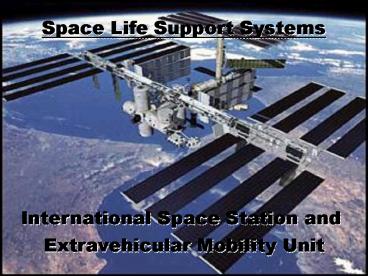Space Life Support Systems - PowerPoint PPT Presentation
1 / 23
Title:
Space Life Support Systems
Description:
Atmospheric Revitalization (EMU/ISS) Atmospheric Composition and Pressure. CO2 Removal ... CO2 Removal in the EMU. LiOH removes CO2 through a two-stage process ... – PowerPoint PPT presentation
Number of Views:52
Avg rating:3.0/5.0
Title: Space Life Support Systems
1
Space Life Support Systems International
Space Station and Extravehicular Mobility Unit
2
Overview
- External Structure of EMU and ISS
- The Primary Life Support System (PLSS) for the
EMU - The Environmental Control and Life Support System
(ECLSS) onboard ISS - Atmospheric Revitalization (EMU/ISS)
- Atmospheric Composition and Pressure
- CO2 Removal
- Temperature Control (EMU/ISS)
3
EMU Parts
4
External Structure of EMU
- From Inside to Outside 11 layers
- Liquid Cooling and Ventilation Garment (LCVG) 2
layers, including liner - Bladder (Polyurethane-coated Nylon)
- Polyester/Dacron Bladder Restraint
5
External Structure of EMU
- Thermal Micrometeoroid Garment (TMG) 7 layers
- TMG Liner (Neoprene-coated Ripstop)
- 5 Layers of Aluminized Mylar
- Northal (Kevlar, Teflon, Nomex)
6
External Structure of ISS
- Insulated by Multi-Layer Insulation (MLI), made
of Mylar and Dacron. - Mylar is a very effective insulator
- Kapton is used to protect the thin layers of
Mylar - Dacron separates the layers of Mylar to prevent
conduction
7
External Structure of ISS
- Micrometeoroid/Orbital Debris (MOD) Shielding is
provided by several layers of ceramics, Kevlar,
and other advanced materials.
8
External Structure of ISS
- Air Pressure is further ensured by a series of
restraint bladders. - Aluminum is the primary material used for the ISS
hull.
9
Extravehicular Mobility Unit (EMU)
- Primary Life Support System (PLSS)
10
(No Transcript)
11
The EMU Atmosphere
- 100 O2
- 4.3 psi
- CO2 and trace contaminant removal through LiOH or
Metox - Secondary Oxygen Supply can last up to 30 minutes
12
(No Transcript)
13
Atmospheric Control in the EMU
http//paperairplane.mit.edu/16.423J/Space/SBE/pro
jects/LSSWEBSITE/Pages
14
CO2 Removal in the EMU
- LiOH removes CO2 through a two-stage process
- H2O in the incoming air reacts with LiOH to
produce LiOH- H2O solid - LiOH- H2O solid reacts with CO2 to produce
Lithium Carbonate and Water vapor - Metox reacts similarly with CO2
- Silver Oxide reacts with CO2 and water to produce
silver carbonate - Metox is the preferable method, because it is
regenerable.
15
ISS Atmospheric Composition
- Composition 21.5 O2, 78.5 N2
- Pressure 14.7psi
- Current Air Source Cryogenic tanks
- Future Air Source Cryogenic Nitrogen tanks,
Oxygen generated from water electrolysis. - H2 will initially be dumped into space but may
eventually be combined with CO2 to produce water
and methane
16
Carbon Dioxide Removal on ISS
- The Carbon Dioxide Removal Assembly (CDRA)
employs a Zeolite Molecular Sieve to cleanse the
cabin air. - Molecular sieves utilize the uniform crystalline
structure with inherent pores and cavities for
adsorption. - Currently, carbon dioxide is expelled into space.
17
Temperature Regulation in the EMU
18
EMU Water Circuits
http//paperairplane.mit.edu/16.423J/Space/SBE/pro
jects/LSSWEBSITE/Pages
19
Temperature Control on ISS
- An air-to-water heat exchanger removes heat from
the cabin atmosphere. - As the air is cooled, the water vapor condenses
and is incorporated into the water supply. - Heat from onboard equipment is removed by cold
water through cold plates.
20
Temperature Control on ISS
- Internal heat is dumped from ISS through
radiators located on the solar panels
21
(No Transcript)
22
What are some other factors to consider?
23
The End































